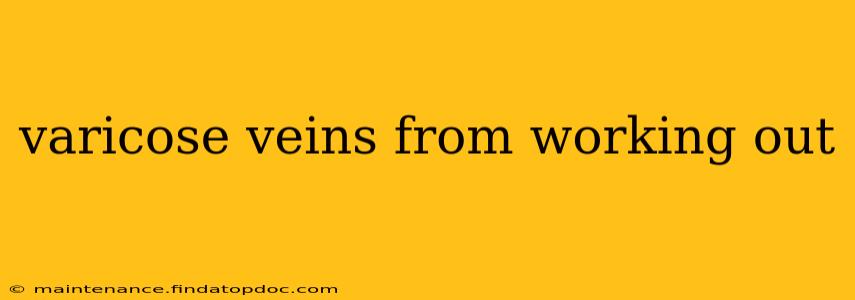Varicose veins, those unsightly, bulging veins often appearing on the legs, are a common concern. While many factors contribute to their development, a question frequently arises: can working out actually cause varicose veins? The answer is nuanced and requires a deeper understanding of the condition and the impact of exercise.
This article will explore the relationship between exercise and varicose veins, addressing common myths and providing evidence-based information. We'll examine how physical activity can influence vein health, discuss preventative measures, and dispel common misconceptions surrounding exercise and varicose vein formation.
Can Working Out Cause Varicose Veins?
The short answer is: not directly. Working out itself doesn't cause varicose veins. However, the increased pressure on leg veins during strenuous activity, particularly high-impact exercises, can exacerbate existing conditions or potentially contribute to their development in predisposed individuals.
Think of it this way: varicose veins are a result of weakened or damaged valves within the veins. These valves normally prevent blood from flowing backward. When these valves malfunction, blood pools in the veins, leading to the characteristic bulging appearance. Intense exercise, especially activities involving prolonged standing or straining leg muscles, may put extra pressure on these already compromised valves, potentially worsening the condition.
What Types of Exercise Might Worsen Varicose Veins?
Certain types of exercise carry a higher risk of exacerbating varicose veins than others. These include:
- High-impact activities: Running, jumping, and other high-impact exercises put significant strain on the leg veins.
- Prolonged standing: Jobs or activities that require prolonged periods of standing can increase pressure in the leg veins.
- Weightlifting (heavy lifting): Straining during heavy weightlifting can increase abdominal pressure, potentially affecting venous return.
- Activities with restricted blood flow: Tight clothing, especially around the legs and waist, can restrict blood flow, potentially worsening varicose veins.
How Can Exercise Actually Help Varicose Veins?
While intense or prolonged exercise can potentially worsen varicose veins, moderate exercise can actually be beneficial for overall vein health. Regular, low-impact activities, such as walking, swimming, and cycling, can improve circulation and strengthen leg muscles, which can help support vein function. These activities promote healthy blood flow, reducing the pressure on veins and potentially minimizing the risk of varicose vein development or progression.
What are the Risk Factors for Developing Varicose Veins?
Several factors increase the risk of developing varicose veins, and exercise alone isn't the primary cause:
- Genetics: Family history of varicose veins significantly increases your risk.
- Age: Varicose veins become more common with age.
- Gender: Women are more likely to develop varicose veins than men.
- Pregnancy: The increased blood volume during pregnancy can strain the leg veins.
- Obesity: Excess weight puts additional pressure on the veins.
- Prolonged standing or sitting: Jobs or lifestyles that involve prolonged periods of inactivity can contribute to poor circulation.
Are there specific exercises I should avoid if I have varicose veins?
If you have existing varicose veins, it's advisable to avoid high-impact exercises that put significant stress on your legs. Consult your doctor or a physical therapist to create a personalized exercise plan that accommodates your condition. Low-impact activities like swimming or walking are generally recommended. Listen to your body and stop if you experience any pain or discomfort.
How can I prevent varicose veins?
Prevention is always better than cure. While genetics play a significant role, adopting a healthy lifestyle can significantly reduce your risk:
- Maintain a healthy weight: Losing weight if you are overweight or obese can reduce pressure on your veins.
- Regular exercise: Engage in low-impact, regular exercise to improve circulation.
- Elevate your legs: Elevating your legs when sitting or resting can improve blood flow.
- Wear compression stockings: Compression stockings can help improve blood circulation in your legs.
- Avoid prolonged standing or sitting: Take breaks and move around regularly.
Conclusion: A Balanced Approach to Exercise and Varicose Veins
The relationship between exercise and varicose veins is complex. While intense exercise might exacerbate existing conditions, moderate physical activity is crucial for overall health and can even contribute to better vein health. The key is to find a balance—prioritizing low-impact exercises, listening to your body, and addressing other risk factors to minimize the potential for varicose vein development or progression. Consult your doctor if you have concerns or experience any symptoms related to varicose veins.
